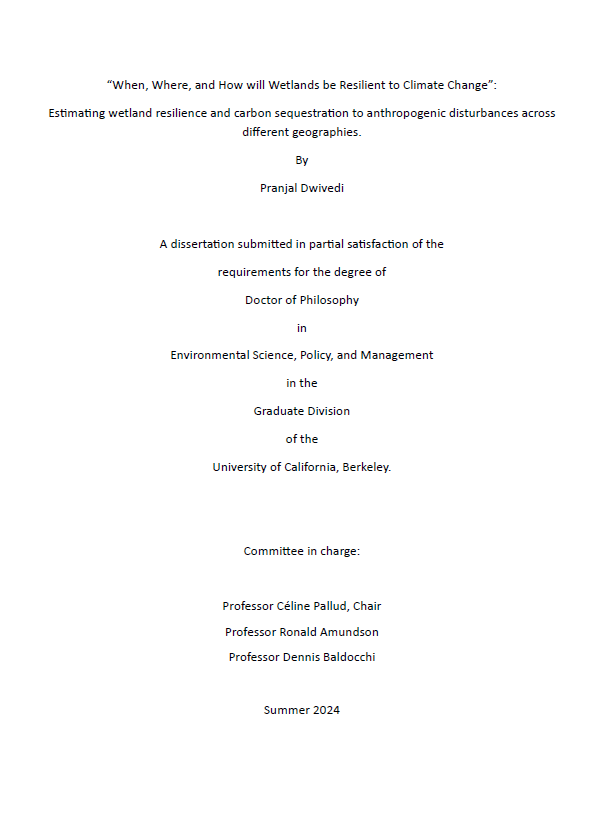It is undeniable that climate change is one of the most pressing challenges facing humanity in the 21st century and that climate is changing at an unprecedented rate, primarily due to human activities such as burning fossil fuels, deforestation, and land-use changes. These activities have contributed to an unprecedented increase in greenhouse gas (GHG) emissions, most notably carbon dioxide (CO2) responsible for bulk of the temperature increase1, but also methane (CH4) and nitrous oxide (N2O), possessing greenhouse warming potentials 28 and 273 times of carbon dioxide, and increase global temperatures.
Wetland or soil carbon storage and GHG emissions are not comparable to fossil carbon emission inherently due to differences in the durability of the carbon impacts and likelihood that those impacts are reversed2. Fossil carbon emissions, in contrast to wetland greenhouse gas emissions, result from combustion of geologically sequestered carbon that had been stored for thousands to millions of years. Approximately 20-35% of emitted fossil carbon will remain for over 3000 years in the atmosphere with clear and quantifiable climate impacts3. However, natural climate solutions are “by nature” not guaranteed to be permanent. Carbon sequestration in soils and wetlands employ photosynthesis to move atmospheric carbon to biomass and belowground carbon pools, which can endure in storage anywhere from months to millennia4. Even if a carbon sequestration practice such as improved agricultural management, or construction and maintenance of wetlands were guaranteed to be maintained for many decades, natural or anthropogenic events may disrupt the system and release the carbon back to the atmosphere, reversing sequestration. However, even if these sequestration rates are temporary and reversible they can still lead to negative radiative forcing reducing or delaying peak global temperatures depending on anthropogenic emissions trajectories5,6. Increasing wetland/soil carbon is unequivocally beneficial from a holistic perspective7–9, with an added bonus of contributing to cooling the climate whenever the flux of GHGs out of the atmosphere and is higher than the flux in the opposite direction.
Wetlands, in particular, have emerged as a significant piece of the puzzle in the fight against climate change10. Wetlands are among the most productive and diverse ecosystems on Earth, providing a wide range of ecosystem services, including carbon sequestration, flood control, water purification, and wildlife habitat. Despite covering only around 6% of the Earth’s land surface, wetlands store a disproportionate amount of carbon, with some estimates suggesting that they could store up to a third of the world’s soil carbon11,12. However, wetlands are also one of the most threatened ecosystems on the planet, with an estimated 35% of the world’s wetlands having been lost since 197013. This loss has been primarily driven by human activities such as drainage for agriculture, urbanization, and pollution14. As wetlands are drained or degraded, the accreted peat and organic matter stored is mineralized and goes back into the atmosphere as carbon dioxide, contributing to further warming of the planet.
However, to effectively protect and restore wetlands, we need a more sophisticated understanding of how they respond to anthropogenic disturbances, such as fires15, pollution16, increasing sea levels and temperatures17,18. Studying wetlands and their response to anthropogenic perturbations is important for several reasons. First, it helps us to identify the drivers of wetland loss and degradation and develop targeted interventions to address these threats. Second, it allows us to quantify the carbon storage potential of different wetland types and regions, which is essential for informing natural climate solution strategies. Third, it helps us to assess the effectiveness of wetland conservation and restoration efforts and adapt our approaches as needed.
In this dissertation, I investigated the impact of anthropogenic disturbances on wetland soil response from two different geographies: a burned subalpine wetland in Wyoming, and three wetland sites comprising a salinity gradient in the Sacramento-San Joaquin Delta. To achieve this, I carried out experiments of increasing complexity, beginning from simple slurry-based experiments to sophisticated flow-through reactor experiments. I simulated disturbance events; namely monthly temperature variations in chapter 1, increased nitrate loadings and salinity concentrations in chapters 2 and 3 and altered root exudate regimes using model compounds in 3 chapter 4. Through my work, I was able to report the effects of both changing porewater/soil chemistry and plant inputs on greenhouse gas emissions and dissolved carbon fluxes.
- Genre de document : Article
- Type de document : Document électronique
- Auteur principal : DWIVEDI, Pranjal
- Editeur : UC Berkeley
- Année de publication : 2024
